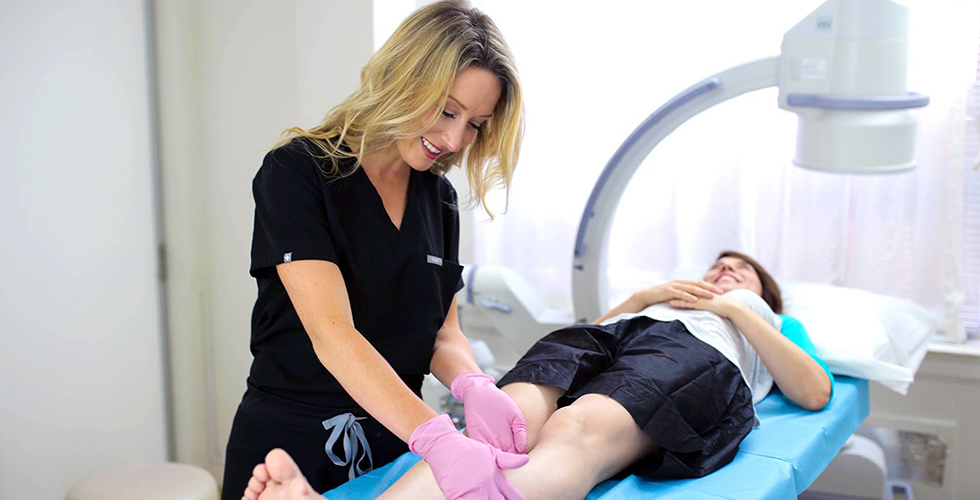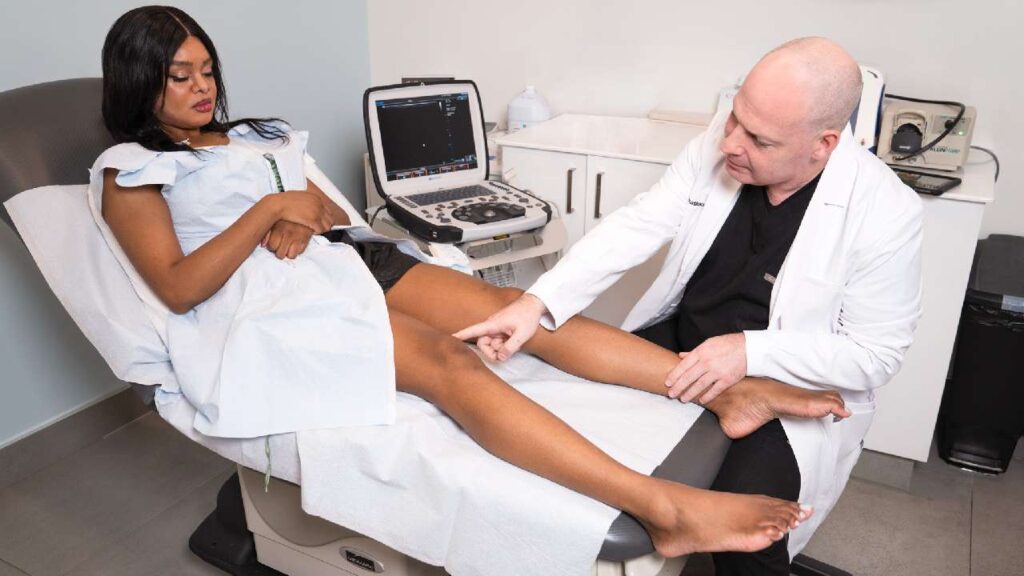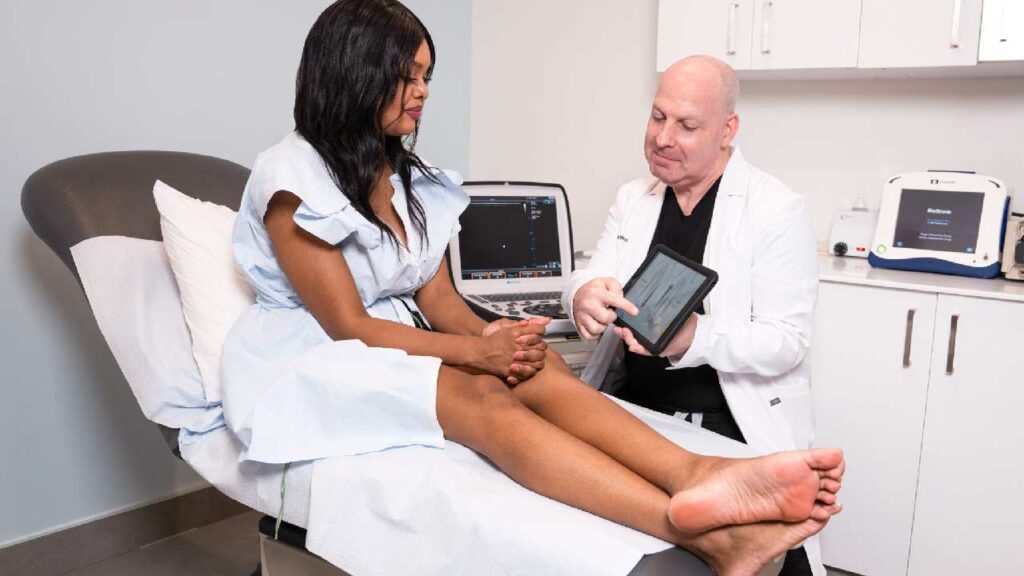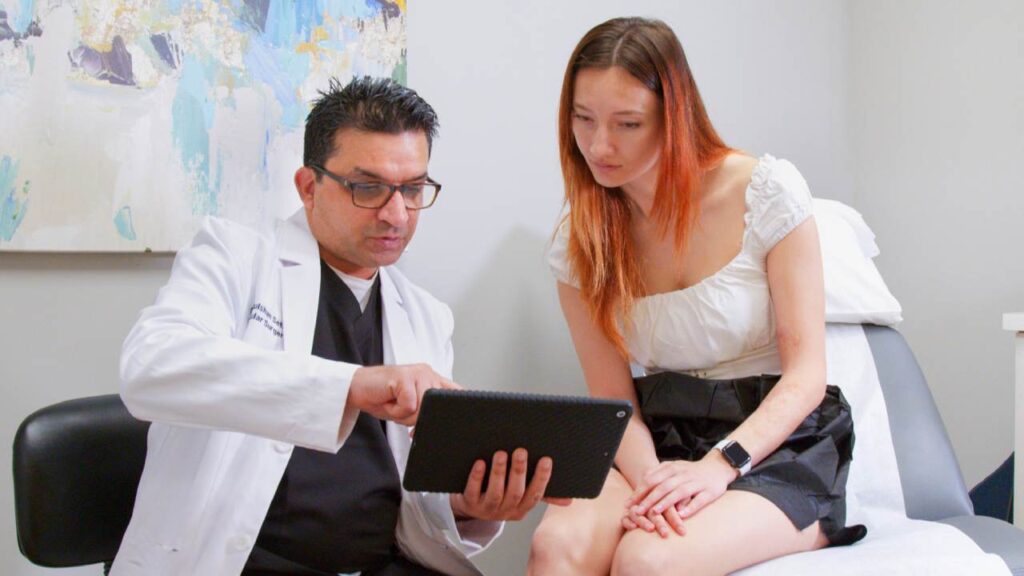How Do NY Vein Treatment Clinics Get Rid of Varicose Veins?
If you’re researching treatment for varicose veins in 2022, you’ll be thrilled to learn there are several new options to choose from. Surgery was once a common treatment for varicosities, but it’s now relegated to certain patients with blood clots or severe tortuosity. In addition, surgical candidates can now benefit from newer techniques like ambulatory phlebectomy, which doesn’t require general anesthesia or large incisions.
Most patients are eligible for non-surgical, minimally invasive procedures that are performed in a fraction of the time of traditional vein stripping surgeries. These include radiofrequency ablation, endovenous laser treatment, liquid or foam sclerotherapy, vein adhesives, and mechanochemical ablation. Click HERE to schedule cutting-edge vein treatment at our award-winning vein clinics in New York. Our procedures are completed in 15-30 minutes and require no general anesthesia, so you can head right back to work after treatment!

Radiofrequency Ablation Varicose Veins Before and After: WTE?
Wondering what to expect (WTE) from minimally invasive varicose veins treatments? Here is a breakdown of WTE from 5 of the top treatments for varicose veins.
- Radiofrequency Ablation- WTE: Doctors insert a tiny hollow needle into the skin and inject tumescent anesthesia around the vein to create a heat buffer. They then deliver thermal energy (radiofrequency) to the walls of the varicose vein. This causes the varicose vein to close, prompting blood to flow into healthy veins, then the varicose vein disappears.
- Endovenous Laser Treatment- WTE: Conducted similarly to radiofrequency ablation, one difference is that endovenous laser treatments use lasers rather than radiofrequency to heat the venous walls. The vein is then sealed off and blood is rerouted back to the heart.
- Sclerotherapy- WTE: There is no heat with sclerotherapy, hence no tumescent anesthesia. Vein doctors inject either a liquid, foam, or premixed foam sclerosant into the vein, which irritates it and causes it to close. Performed with tiny needles, this procedure is used for both spider veins and varicose veins and takes just a few minutes.
- Vein Adhesives- WTE: Cyanoacrylate glue, long used in cardiac procedures, is now formulated for safe closure of varicose veins. Doctors inject glue to seal the vein off and improve circulation, rather than allowing blood to pool in the varicose vein.
- Mechanochemical Ablation- WTE: This procedure inserts a tiny catheter through a small incision. It rotates to disrupt the venous walls, and then releases a sclerosant to further irritate the vein and cause its closure. Like the previous procedures on the list, this is a non-surgical technique that allows patients to be mobile after treatment.
What’s the Best Clinic for Varicose Veins in NY?
If you’re looking for the best clinic for varicose veins in NY, start by assessing the facility’s capabilities and the vein doctor’s credentials. Some vein treatment clinics in New York don’t have actual vein doctors on staff, so look for board certified physicians, like our Harvard-trained vein doctors in NY.
Also, look for a vein clinic that specializes in minimally invasive vein treatments, and favors them over surgery for patients who are eligible. Unnecessary surgery means unnecessary costs, risks, side effects, and recovery time. So, choose a vein treatment clinic in New York with the latest treatment devices and state-of-the-art techniques.
When Should I Get My Varicose Veins Treated?
The sooner you treat varicose veins, the better the outcome. Varicose veins and spider veins often stem from an underlying disease called Chronic Venous Insufficiency. This involves broken valves in the veins that allow blood to flow in reverse. As blood pools, pressure builds within the vein. That excess pressure generates the bulging varicose veins you see at the surface, as well as the clusters of spider veins that branch out from overburdened veins. Treat varicose veins promptly to prevent worsening vein damage, as well as the problematic symptoms of Chronic Venous Insufficiency described below.
What Happens if Varicose Veins Are Left Untreated Too Long?
If varicose veins go untreated, their size, protuberance, and symptoms can increase. Patients with varicosities experience things like leg heaviness, cramping, restlessness, swelling, hyperpigmentation, and itchiness. As vein disease progresses, some patients develop venous ulcerations, venous stasis dermatitis, bleeding that’s hard to control, and complications like blood clots or deep vein thrombosis. No one can predict the progression of varicose veins. Some remain asymptomatic, while others become severely debilitating. Treat varicosities early to prevent complications.
Do Asymptomatic Superficial Varicose Veins Need Treatment?
Some patients will not develop any symptoms with superficial varicose veins, and some veins do not require treatment. But only a qualified vein doctor can determine the necessity of treatment. Our award-winning vein specialists use Duplex and Doppler Ultrasound to map out venous issues, valve failure, and connecting veins prior to treatment.
We identify the source of the varicosity, as well as any potential problems like diseases, blood clots, and paths the treatment might travel beyond the varicosity. In doing so, we not only successfully treat varicose veins, we also minimize risks and side effects. For many patients, treatment is a medical necessity. For others, treatment is optional and is often selected to eliminate the appearance of varicose veins.
Can a Leg and Vein Doctor Treat Chest Veins or Spider Veins?
No two vein clinics in New York are exactly the same. Some specialize in surgical procedures. Others are strictly cosmetic, using surface lasers or liquid sclerosants for things like facial spider veins. If you have more than one type of vein damage, choose a qualified vein expert for treatment. Our accredited vein clinic treats everything from the smallest spider veins to the most complicated varicose veins, as well as vein disease.
As mentioned, vein damage often stems from Chronic Venous Insufficiency, so treating that is essential to preventing recurrent vein issues. Some vein clinics aren’t trained to identify or treat vein diseases, but our doctors not only find it, they also treat it within minutes. Ask your vein doctor, “What do they do to get rid of varicose veins like mine,” and look for minimally invasive options in their answer.
Does High Blood Pressure Cause Varicose Veins or Vice Versa?
Patients often wonder whether varicose veins are generated by high blood pressure or vice versa. High blood pressure in the arteries (known as hypertension) and elevated pressure in the veins are two distinct issues. Arteries pump oxygenated blood from the heart throughout the body. Veins rely on valves to return blood to the heart. These valves in the veins must close once blood passes through to prevent the venous reflux common with Chronic Venous Insufficiency. When valves fail, endovenous pressure increases, creating varicose veins and spider veins.
But arteries don’t have valves. High blood pressure in arteries occurs when the force of blood against the arterial walls is too high. This is caused by narrowing of the arteries from aging or obesity, medications or drugs, or diseases. Hypertension in arteries is not the same as elevated endovenous pressure. However, many patients have both issues, and veins and arteries work in unison, so research is underway to determine how the issues interact and how to treat both successfully.
Will Varicose Veins Cause High Blood Pressure Eventually?
Bulging varicose veins in your legs are different from bulging veins in the forehead when you’re stressed out. If blood pressure is elevated due to strenuous activity, heat, or stress, some veins will naturally enlarge temporarily to contain the excess. In areas with less fat, like the forehead, these will be visibly more pronounced with hypertension. However, a healthy vein shrinks in size once the blood pressure drops.
Conversely, a varicose vein in the leg won’t completely shrink from sight without treatment. That’s because the vein is unnaturally enlarged by malfunction, and it’s continuously engorged, rather than temporarily. So, varicose veins don’t directly cause high blood pressure. But talk to your vein doctor about either condition, since both should be taken seriously.
What’s the Best Vein Clinic If I Have High Blood Pressure?
If you have a secondary issue like high blood pressure or heart disease, it’s imperative to choose a board certified vein specialist to treat varicose veins. Blood vessels carry out essential tasks like delivering oxygen and nutrients to cells. You should never trust your venous health to an unqualified specialist, especially if you have hypertension or vein disease. Choose our renowned vein experts who are Ivy League-trained, board certified, and practicing in a facility that’s approved by the Intersocietal Accreditation Commission.





